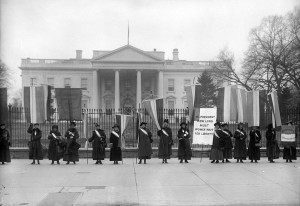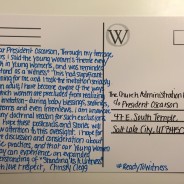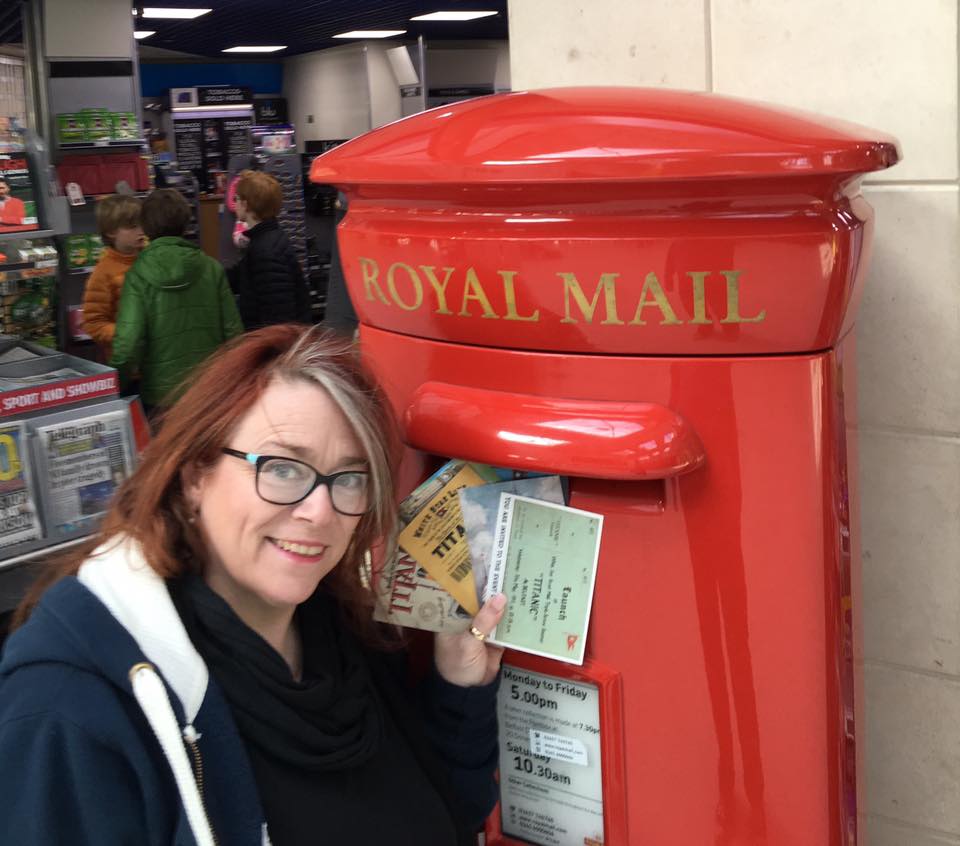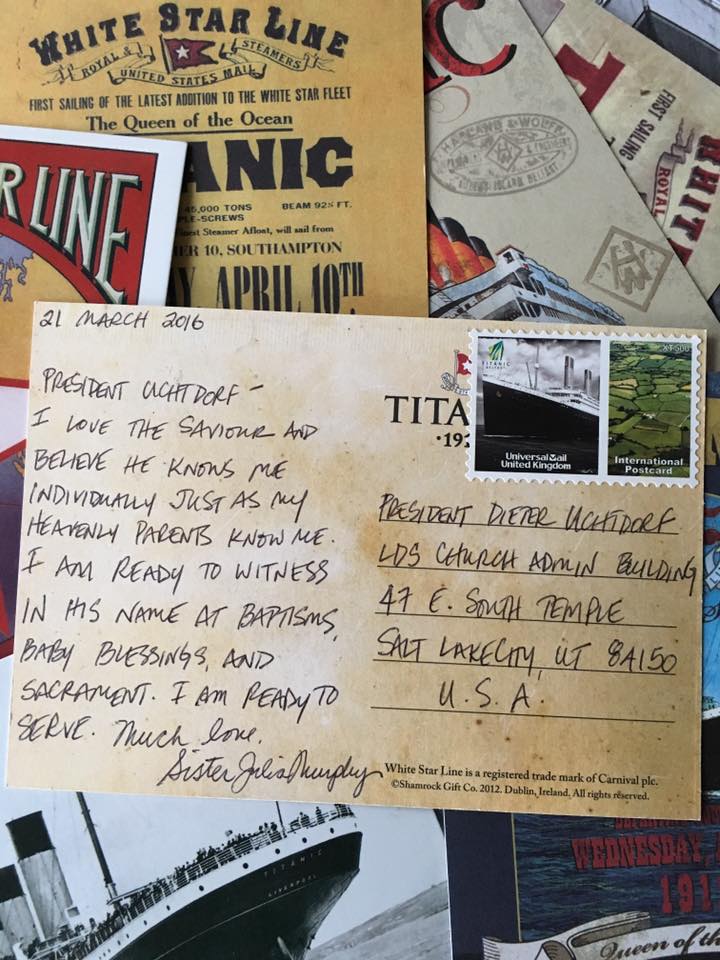Ordain Women April 2016 “Ready to Witness” FAQ
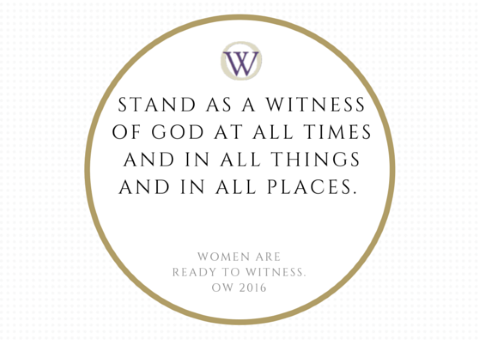
Why are you engaging in the April Ordain Women “Ready to Witness” Action?
While we hope for both the blessings and the authority of priesthood ordination, we stand with many Mormon women in calling for a number of policy changes that will foster a more inclusive church. We applaud recent Church initiatives, including an emphasis on collaborative, gender-inclusive councils, greater encouragement for women to serve missions, and the opportunity for women to both pray and speak in general conference. This April’s “Ready to Witness” action encourages a change in the present policy that denies women the ability to be official witnesses at LDS baby blessings, baptisms and temple marriages and excludes women from participating in baby blessings and being present during young women’s worthiness interviews. In joining together, we are punctuating our commitment to Mormonism and our fervent desire that Church policies and practices better reflect the inclusiveness of the gospel of Jesus Christ.
What exactly is going to happen?
The Ordain Women “Ready to Witness” initiative invites women and male supporters to download or purchase a postcard or fill out our online form and share their personal stories and hope for a change in these policies with a general Church leader of their choice. Such stories can:
- Explain what it feels like to sit outside the circle when your baby is blessed and be excluded as an official witness to this significant moment in your child’s life.
- Share the moment you were told that you could not act as an official witness to your best friend’s baptism, because present Church policy states that witnessing is a role reserved for men who hold the priesthood.
- Describe the concern you feel about young women, alone in a room with an adult man during a “worthiness interview,” being asked personal–at times probing–questions without a woman present to witness.
- Tell of the moment you realized that your Young Women’s president could not serve as the witness at your temple sealing because presently only men are considered acceptable official witnesses.
- Ask why, when women were chosen to serve as the first witnesses of the resurrected Christ, such policies keep women from serving as official witnesses to these moments in a church that bears His name.
Ordain Women will be tracking how many submissions our leaders receive, so please share your story online with us HERE.
On Friday, April 1, supporters of the “Ready to Witness” initiative will gather at 10:00 AM for a brief devotional at City Creek Park and then walk to the Church Administration Building to deliver the stories we collect. We will be in front of the Church Administration Building on Friday, April 1, Saturday, April 2, and Sunday, April 3, during daylight hours, to collect additional postcards and personal stories and then deliver them to Church leaders on Monday, April 4. We invite all who support this effort to join us in front of the Administration Building during one or all of these days.
You can purchase postcards HERE or you can use the images and information HERE to print them yourself. You can also use any other postcard you choose. Mail your postcards to any General Authority or Church Officer with whom you wish to share your story. The address is:
Church Administration Building
47 E South Temple
Salt Lake City, UT 84150
Ordain Women asserts that it engages in faith-affirming, religious action. How is this compatible with the LDS doctrine of continuing revelation?
Our understanding of the gospel is that the heavens are yet open. As we obtain more light and knowledge, we expect Church policies and practices to reflect that increased wisdom. The 9th Article of Faith states: “We believe all that God has revealed, all that He does now reveal, and we believe that He will yet reveal many great and important things pertaining to the Kingdom of God.” That Church members play a role in this process is demonstrated throughout the Doctrine and Covenants. We ask questions and articulate the need for revelation. According to President Dieter F. Uchtdorf, “… if we stop asking questions, stop thinking, stop pondering, we can thwart the revelations of the spirit. Remember, it was the questions young Joseph asked that opened the door for the restoration of all things. … How often has the Holy Spirit tried to tell us something we needed to know, but couldn’t get past the massive, iron gate of what we thought we already knew?” It is our faith in this process that compels us to action.
Is this a protest?
No. It is a petition for inclusion, and, as such, we see it as both faith-affirming and consistent with the gospel of Jesus Christ.
Why are you advocating in public?
Mormon women are not ordained to the priesthood, which means they lack positional authority and the institutional power to influence church-wide policy. Public advocacy is one of the few options open to those of us who actively seek the ordination of women and other equitable changes in Church practices and policies. Increasingly, women are finding the courage to express their desire to participate more fully with men in all aspects of church governance, service and sacred ordinances.
If I can’t join you at the Church Administration Building, but want to be supportive, what can I do?
First and foremost, you can join hundreds of others in sending personalized postcards–as detailed above–to general Church leaders of your choice, and then share your story with us. You can also continue the conversation by discussing your thoughts about women’s greater inclusion in the Church with friends, family and members of your local congregations; spread the word on your personal Facebook pages, blogs and Twitter accounts; and, add your profile to ours at ordainwomen.org.
I’m afraid to participate with you. Do you anticipate disciplinary action?
We cannot predict the response of individual church leaders. Many of our local leaders have been loving and supportive. Others have not. We believe our actions are consistent with the gospel of Jesus Christ and the doctrines of the LDS Church. We have worked with the government of Salt Lake City to obtain the appropriate permits. Though our action is not a protest, we have applied for a “free speech” permit. The City of Salt Lake requires it of any large group gathering in public spaces, such as City Creek Park and the sidewalks near the Church Office Building. We recognize that there might be social or personal costs to participants. Only you can weigh your circumstances and concerns and decide if this is the right thing for you to do.
We are Ready to Witness
As a woman in the Church and as a young woman growing up, I did not establish strong lasting relationships with men with whom I would have felt comfortable having as a witness to my marriage. I did, however, develop wonderful impactful relationships with the women in my life who guided me through my teenage years.
Inasmuch as having women witness special moments and ordinances within the church could alleviate some of the pain and confusion felt by women who do not have deep ties to Mormonism but who wish to be supported in making and keeping sacred covenants, I humbly ask for the prayerful consideration that women be allowed to witness.
Natasha Walls Smith
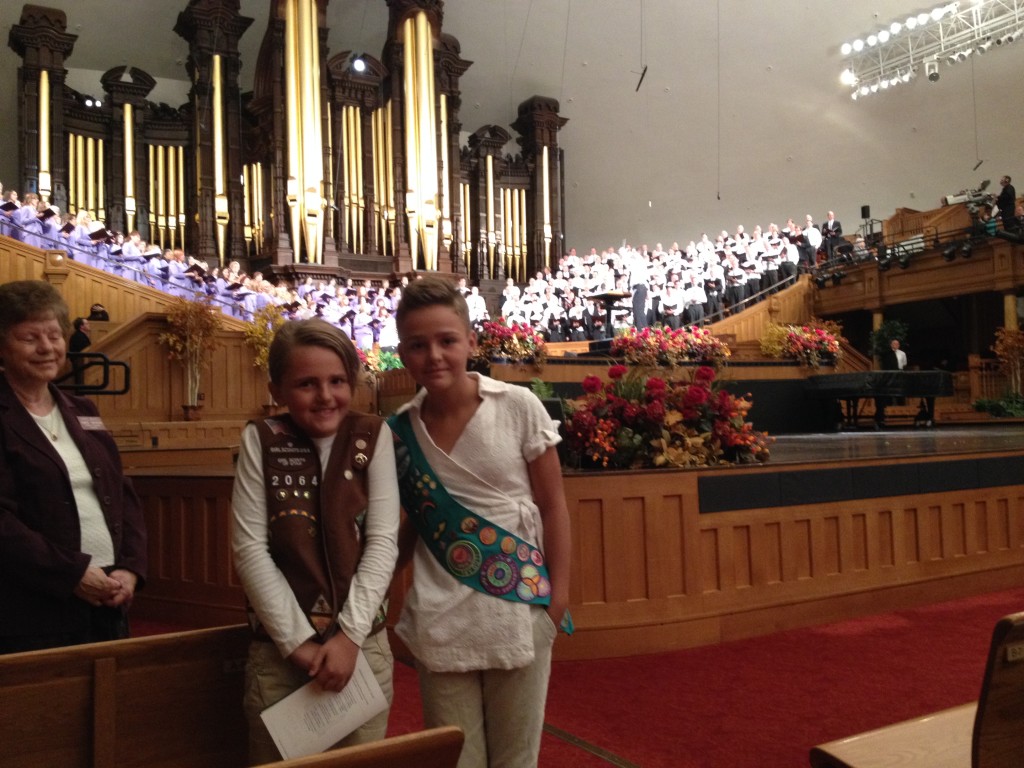
two girl scouts standing in front of the Mormon Tabernacle Choir
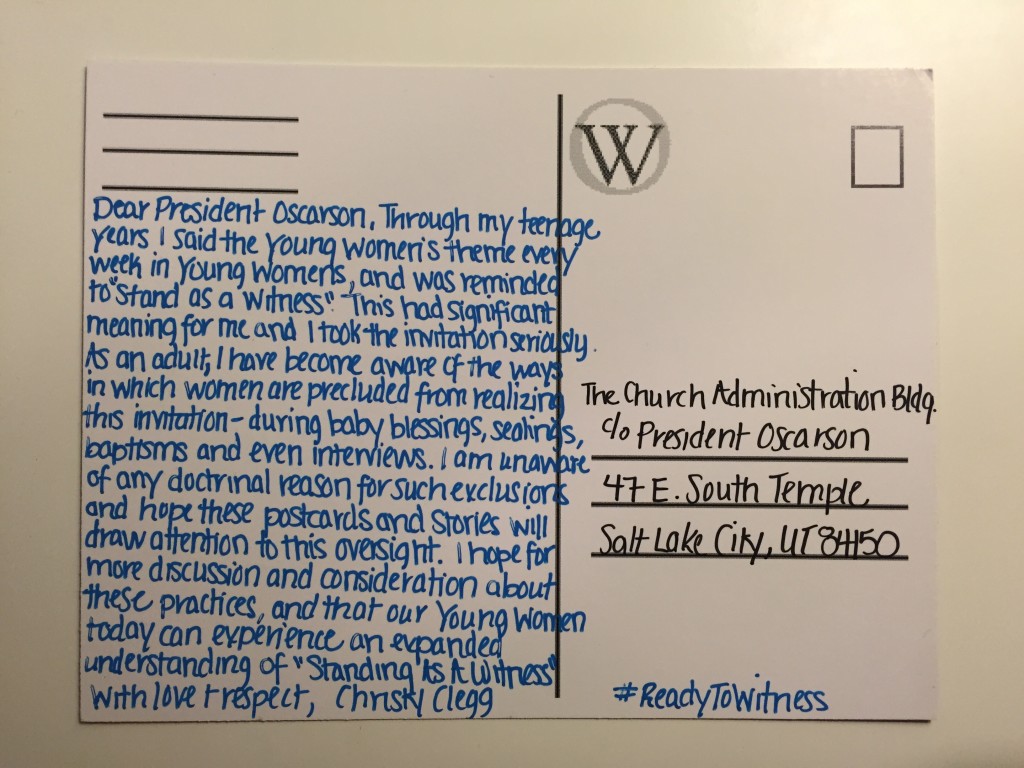
I’ve spent a lifetime in the Church witnessing—unofficially—sacred moments in the lives of my children, other family members and friends—baby blessings, baptisms, temple marriages. I watched as my father and father-in-law—not my mother or my mother-in-law—officially signed my marriage documents in the St. George temple. I loved them both but felt the sting of women’s exclusion on one of the most significant days of my life.
Christ considered Mary an appropriate witness to, arguably, the most significant moment in the history of Christianity—His resurrection—at a time 2,000 years ago when women often were not legally-recognized witnesses. Why, then, in 2016, are women still unable to serve as official witnesses to blessings, baptisms, and marriages in a church that bears His name?
Lorie
——
“I have three sons, and this means I am shut out of much of their spiritual progression. I won’t be involved in many of their important moments, like ordination. But there is no doctrinal reason I can’t be an official witness to their baptisms and sealing. Please, please reconsider these men-only policies.”
Leah Marie
——
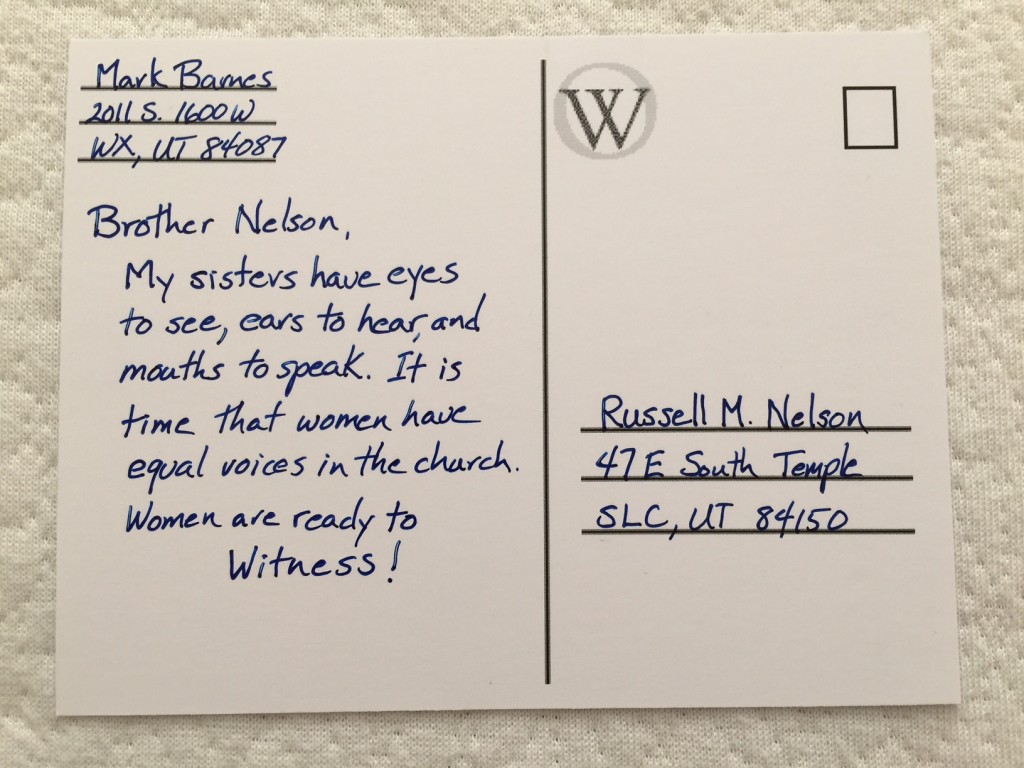
Postcard to Russell M Nelson
—–

photo of a strong adult woman and a smaller photo of her in her youth.
I heard the anguish of sisters who had been asked inappropriate questions in their worthiness interviews and the trepidation of sisters who were worried about the questions their children would be asked. Although I tried to comfort and reassure these sisters, I could not help them or myself come to peace with a Church policy that prevented them from witnessing these interviews.
——
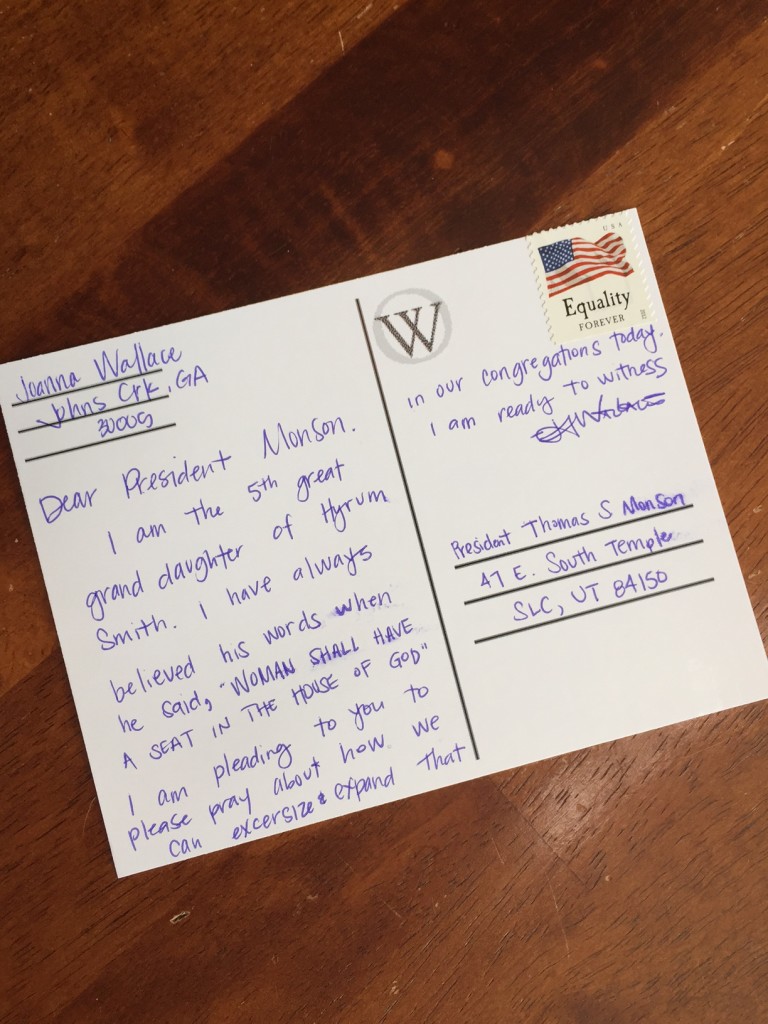
Postcard addressed to President Thomas S. Monson
——
We are Ready to Witness.
JOIN US.
Witnessing the vote.
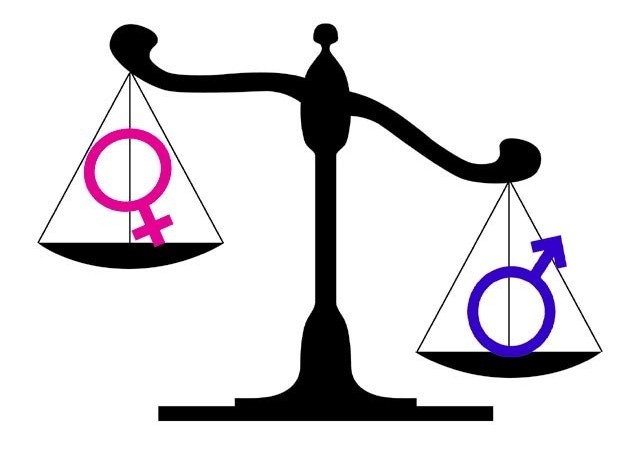
Tonight I cast my vote in my party’s presidential contest. I noticed that women comprised a majority of the officials, who were tasked with witnessing the vote to ensure that it was done correctly. This has been the case nearly every time I have cast a vote. I am not aware of a single claim that women are less capable than men to properly witness voting.
As a litigator, I regularly work with witnesses. Despite my work with hundreds of witnesses over 28 years, I have yet to detect a gender difference. Both women and men are capable of observing and reporting events.
Like most Americans, I regularly watch video of Congressional hearings on the news. Both men and women are called in front of committees to testify. There are witnesses who crumble and witnesses who perform well under extraordinary pressure from the committees. It is clear that gender is not the distinguishing factor between successful and unsuccessful witnesses.
So, we ask you Dear Brethren, why can’t women witness in the Church? If women can witness the vote, surely they can witness a baptism. If women can witness in a court of law, obviously they can witness in a holy temple. If women can witness before Congress, of course they are hold their newborn child and witness her blessing.
There is no question that women are capable of doing far more in the Church than witness. But, allowing women to witness is a good place for change to start. We at Ordain Women state clearly – Women are Ready to Witness!
Mark Barnes, the author of this post, is on Ordain Women’s Executive Board as Chair of the Finance Committee.
Standing on the Shoulders of My Ancestors: My Tribute to My Aunt — Miss Elease Spencer
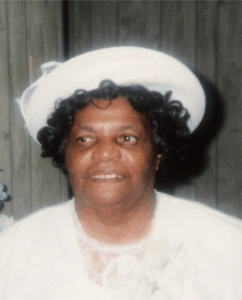
Miss Elease Spencer at age 80
The legendary Billie Holiday once remarked that “[y]ou can only get to where you at by way of where you been.”
I know that I became the person I am today not only because of my own journey but also because of the journeys of my ancestors. I am deeply indebted to my ancestors and during Women’s History Month, I want to pay homage to my oldest maternal aunt, Elease Spencer, and her indomitable spirit that has allowed her to survive and succeed in the face of illness, hardship, and discrimination.
Aunt Elease (born March 20, 1916) was the oldest surviving child born to my maternal grandparents, Joshua Spencer and Bertha Mae Best Spencer. My grandmother had suffered four (4) miscarriages prior to the birth of Aunt Elease and the entire family rejoiced when Aunt Elease was born.
From her earliest years, Aunt Elease was a survivor. As the great influenza pandemic of 1918 and 1919 swept through Georgia, both Aunt Elease and her young brother, Joshua, Jr., were stricken with the disease. Although both children were terribly ill, Aunt Elease did recover and, in keeping with the deep love for her family that she has displayed throughout her life, her first concern upon recovery was for little brother as she tearfully asked “Where is the baby?” Unfortunately, little Joshua had succumbed to the disease.
My family placed great value on religion and education and my maternal grandparents instilled in Aunt Elease a keen appreciation and desire for religious and secular knowledge.
She joined New Robbins Branch Baptist Church where her mother was a member. She would also attend St. Paul Missionary Baptist Church, where her father was a member and a deacon. She served in the Baptist Training Union (the youth department) and the Women’s Missionary Union. She was particularly interested in learning about the history of women in the early Church and shared her knowledge with her younger sisters. She learned from her mother that, because the work of caring for their families often left Black men with little time or energy for organizing and planning religious activities and events, the survival of and growth of their local Baptist church often depended on the efforts of the women.
Aunt Elease attended grammar, elementary school, and high school in segregated schools in Screven County. The schools for Black children were referred to as “colored schools” and they were often constructed poorly and did not have enough books for all of the students. The books that were available were “hand me downs” from the students at the “white schools” and were often in poor condition. However, Aunt Elease did not let either the condition of the buildings where she attended school or the lack of books or school supplies stand in the way of her desire for knowledge.
Aunt Elease graduated from Screven County Agricultural School (referred to as Sylvania Colored High School) in the spring of 1934, and, although there had been other students in her class, she was the only student to graduate that year as many of her classmates had been forced to drop out due to help support their families. Her graduation was such a momentous occasion that most of the townspeople came to see her walk across the makeshift stage.
After graduating from high school, Elease decided to pursue her dream of obtaining a college degree and becoming a teacher. She enrolled in Georgia State College (now known as Savannah State University) in Savannah, Georgia. Initially, she attended college on a part-time basis while she worked as a teacher.
Aunt Elease began teaching in a one room school in 1935; her pay was $35.00 per month. In 1937, the school board threatened to take half of her last paycheck to pay for supposedly damaged books, a common penalty imposed upon Black teachers. Aunt Elease protested and told the superintendent that before he took half of her check, he could take it all. She then threw the check on the table and walked out of the room. The school board later mailed her entire check to her. However, that fall the school board refused to assign Aunt Elease a school. It was not until January that she began teaching again, when the President of Georgia State College helped her secure a position in Hancock County. Elease’s entire family was very excited when she obtained another teaching position. Her younger brother, Brantley William (B.W.) even made up a little song of thanksgiving.
When she resumed teaching, Aunt Elease used some of the proceeds from her pay to help her parents pay to replace the wooden shutters on the windows in their home with glass windows and to wire their home for electricity. In a time when many Black families were losing land that their ancestors had purchased in the early 1900s, Aunt Elease also helped her father pay his share of the mortgage on family owned land, thereby preserving that land for future generations.
In 1943, Aunt Elease began attending college on a full-time basis. She graduated from Georgia State College in the summer of 1945 and, in so doing, became the first of her siblings and cousins to obtain a bachelor’s degree.
In 1945, after graduating from college, Elease received a two-year appointment as principal of Wilkinson County (Colored) High School. It was unusual for a woman to be appointed principal, but Aunt Elease had a college degree and many men were still away in the war. During that time, she used some of her salary to help defray some of the college expenses of her younger sister (my mother), Josie Earle Spencer, starting a tradition of older family members helping younger family members with their educational expenses.
In 1947, when her two-year appointment ended, Aunt Elease was informed that her services as principal would no longer be needed and that the position would be filled by a man. At that point, Aunt Elease returned to the classroom. In 1950, she decided that she wanted to finish her master’s degree and she attended graduate school at Boston University from 1950 to 1952. She retired from teaching in the mid-1950s.
Aunt Elease celebrated her 100th birthday on March 20, 2016. She has lived a life full of illness, hardship, and discrimination. Through it all, however, she has maintained her faith in God and her indomitable spirit. It is that spirit that inspires and motivates me to do all that God has called me to do. It is that spirit that will not let me sit idly by in the face of oppression and injustice. It is that spirit that compels me to stand with my sisters and brothers in The Church of Jesus Christ of Latter-day Saints as we seek full equality in faith.
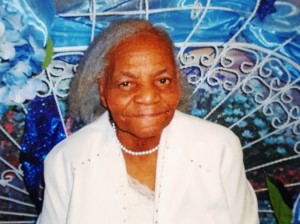
Miss Elease Spencer at age 95
I have a voice.
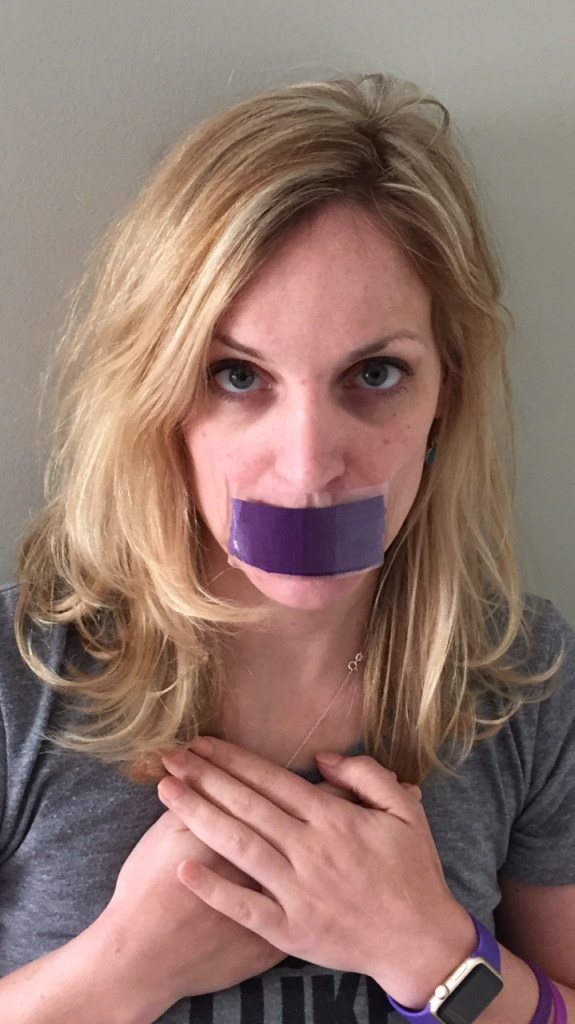
Woman with her mouth taped shut
I am a Mormon woman with a voice. It started out small, like the little stream we sing about in primary…. Give, give, give…. and that was my voice… That voice fit me, I loved to give and celebrated my identity in building others. Through the years I’ve had my voice silenced. Silenced when I had questions about my faith’s past, silenced when I wondered aloud if I could work outside the home and still be a mother. or silenced when I wanted to be more involved in my children’s baptisms. Yes, at the time I still felt like the role of that still small voice was important, and a force to be reckoned with. After all, it’s the stream that nourishes the ecology of the entire mountain, right??
In Shakespeare’s Much Ado About Nothing, the young Hero is the shining light in her Father’s eyes. Her voice can even be heard in the laughter of others and their respect for her. But on her wedding day she falsely accused of being impure and within 5 minutes into the scene every man in the cast (save one) turns against her, including her betrothed, her father and uncle. Her voice repeating that she is innocent goes on deaf ears. Regardless of Hero’s testimony otherwise and the witness of her cousin, another woman. When bride realizes that her voice means nothing to the men that she loves so dear she faints from a broken heart.
How often do we see that and experience that today? Are we witnessing the devaluation of women’s experiences? The voices of women being silenced. I witnessed my friend, Kate, silenced when her pleas to remain in the church went ignored. I witnessed my friend, Kristy, silenced when she pleaded with her leaders to hold her daughter during her baby blessing. I witnessed too many friends abused and broken plead with their leaders to stop the sexual abuse that was happening in their wards only to be told to be faithful instead of their attackers be held accountable. I have witnessed when a primary leader asked my daughter how it felt to not have the priesthood in the home. I have witnessed my friend, Rebecca, silenced as she plead for members of her ward to be seen, as she saw their pain and wanted their needs addressed. I have witnessed Aunts and cousins be silenced as they are excluded from weddings for having thoughts their neighbors disapproved of. I have witnessed the hurt of too many women’s voices being silenced.
Last conference, President Nelson pleaded, “My dear sisters, whatever your calling, whatever your circumstances, we need your impressions, your insights, and your inspiration. We need you to speak up!”
So here I am! Answering you Elder Nelson. I am a Mormon woman with a voice. It is time for that voice to evolve from a little stream to grow. I am a Mormon woman who will follow in the footsteps of my 5th great grandfather, Hyrum Smith, and believe his words, “Woman shall have a seat in the house of God”. I am ready to share that voice as I witness blessings and baptisms and pain. I am ready to speak up again knowing that all my sisters have had their voices silenced one too many times. We are all ready to be heard and ready to witness. We are Mormon women with voices!
Joanna Wallace, the author of this post, is on Ordain Women’s Executive Board as Co-Chair of the Social Media Committee.
Happy Birthday, Ordain Women!
On March 17, 2013 the Ordain Women website launched to no fanfare that I am aware of. That evening, I was quietly sitting at my computer when someone posted on a feminist Mormon Facebook group I belonged to. It was a link to the website www.ordainwomen.org and the post simply said, “Have you seen this?!?!” I clicked on the link and when I read the words “I believe women should be ordained” I felt my heart leap. This was the answer to my years of prayer!
I spent the night reading every profile. I read the instructions for how to submit a profile. Then I prayed. I prayed to my Heavenly Father that I would know if this was what I had been waiting for. Was this the promised answer I was told would come? I was terrified at the thought of publicly acknowledging my desire to be ordained, but I knew, immediately, that this was something I had to do. I spoke to my husband—with tears in my eyes I told him that, though it might cause me trouble, the Spirit was telling me it was time—and he gave me his full support.
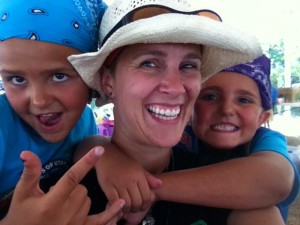 It has been three years since I saw that website. And tomorrow, it will be three years since I submitted my own profile. It did not come without a cost, but I believe this is where my Heavenly Parents have guided me. It has changed me, changed my life, and changed my faith community.
It has been three years since I saw that website. And tomorrow, it will be three years since I submitted my own profile. It did not come without a cost, but I believe this is where my Heavenly Parents have guided me. It has changed me, changed my life, and changed my faith community.
I am incredibly proud of the work we have done. Since 2013, we have seen more than 600 individuals share their profiles. We have been joined, in body or in spirit, by thousands of people at actions around the world. We have been a part of the conversation around women and their role in the Church of Jesus Christ of Latter-day Saints. And that conversation will continue. It fits the model of revelation given as far back as the Old Testament and it is part of the promise of the 9th Article of Faith.
Happy Birthday, Ordain Women!
We Are Ready to Witness
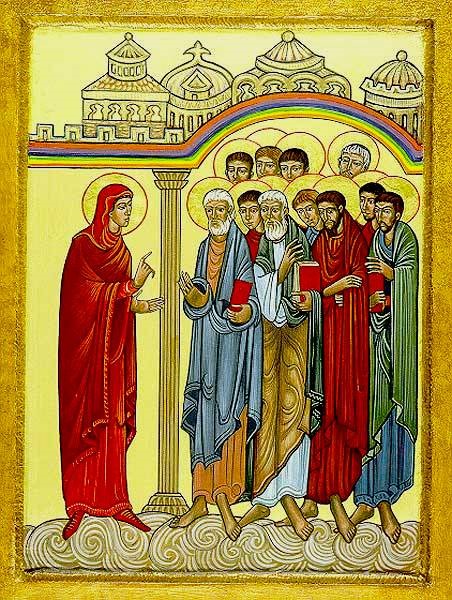
Mary Magdalene, the “Apostle to the Apostles”
11 ¶But Mary stood without at the sepulchre weeping: and as she wept, she stooped down, and looked into the sepulchre,
12 And seeth two angels in white sitting, the one at the head, and the other at the feet, where the body of Jesus had lain.
13 And they say unto her, Woman, why weepest thou? She saith unto them, Because they have taken away my Lord, and I know not where they have laid him.
14 And when she had thus said, she turned herself back, and saw Jesus standing, …
16 Jesus saith unto her, Mary. She turned herself, and saith unto him, Rabboni …
17 Jesus saith unto her, Touch me not; for I am not yet ascended to my Father: but go to my brethren, and say unto them, I ascend unto my Father, and your Father; and to my God, and your God.
18 Mary Magdalene came and told the disciples that she had seen the Lord, and that he had spoken these things unto her. John 20:11-18
As we approach the Easter season, this passage from John is extraordinary, not only in its testament of the resurrected Christ but also because of whom Christ chose as the first witness of His resurrection—a woman, Mary Magdelene. Women in many ancient cultures were not considered competent witnesses. In other words, they were either not legally allowed to be witnesses, or there were severe restrictions on their ability to act as legitimate witnesses. Because of such restrictions, it is remarkable that Jesus appeared first to Mary. That Early Christian writers referred to her as the “apostle to the apostles” further punctuated the importance of her role as a witness to, arguably, the pivotal event of Christianity.
If Christ considered Mary an appropriate witness to this significant moment–indeed, instructed her to testify of it to His disciples—why then are women presently unable to serve as official witnesses to blessings, baptisms, and marriages in His church?
Are these policies mere cultural artifacts, like other practices now long-abandoned in the modern, Western world, such as prohibitions on women speaking publicly, or inheriting land, or voting, or serving on juries? More crucially, are such policies worthy of a church that bears Christ’s name?
We, like Mary before us, are ready to witness.
Transcending Time Through Gumbo
March is Women’s History month. As I think about this in the context of Mormonism, I think about how personal history is such an important part of our religious practice. This personal history becomes part of our individual narratives. Unfortunately, my attempts to collect my personal history do not extend beyond this continent. Even genealogy is a penetrating reminder of the continual tragedy of slavery and its far-reaching effects. Despite this, I have realized that I have found connection to the women from my personal history through personal ritual. Sure, it doesn’t reach far beyond the continent and beyond the grips of slavery, but it makes me feel closer to the women who have gone before me.
Every year, I perform my own ritual or homage to the women in my family. The history I have to embrace comes in the form of recipes, adorned with tips and tricks passed on by the experienced hand of each woman who lovingly guided the ingredients into the masterpieces I have now. Each recipe has been molded by a collective effort—an effort I know was not limited to my direct line, but includes women that were probably called aunt, cousin, mother, or sister, regardless of bloodline. I like that. I like knowing that each of these meals is a communal act that brought women and families closer together. Every year I perform my own role and make my own contributions to honor these recipes and women.
I find that I feel most connected to the women I descend from when I make gumbo each fall. Gumbo is love. It is an investment of time. It is peeling, cracking, stirring, cutting, deep nutty brown that you pour into the hearts of family: love. Anyone who has ever made real slow Louisiana gumbo knows that this process is certainly a production. Do it right (or wrong enough), and you may even find a real come-to-Jesus moment in that pot of gumbo. That is why it only gets made once a year in my home. I usually make it during October General Conference. It seems like the right time of year for me; it’s just before the holiday season, but in time to welcome a new rhythm and pace of life. It is usually my farewell to summer and my hello to shorter days that welcome the warmth and comfort of something heartier.
I perform my gumbo ritual faithfully. Each year, I call my grandma to ask her for her old gumbo recipe, and each year she proceeds to look for it and then tell me that she can’t find it anymore (this part has been going on for the last five years or so). I, in turn, lament that I didn’t write it down the previous year even though I had said that I would. I’m not sure my grandma knows that this is our pattern—that we perform the same conversation each year—but I find comfort in its repetition and continuity. Besides, honestly, I can’t take the time away from the all-consuming ritual of making gumbo to simply assess gumbo and record the recipe. I can’t disrupt the process.
Together, my grandmother and I sit on the phone and brainstorm the standard ingredients from the previous year. The longer we talk the more tips my grandmother remembers. It becomes “Aunt So-and-So would do this” and “Cousin So-and-So would do that.” My most favorite part is that each gumbo conversation begins and ends with “Oh, Tasha don’t forget your white potato. You need to have one peeled white potato. It doesn’t seem like it would, but it really works.” I respond with, “Grandma, you know I’m not going to forget the potato, I always remember the potato. I leave it whole, right?” I then promise to let her know how it turns out. We have several more of these conversations as I prepare to make my gumbo.

Just after we watch the first session of conference, I gather my ingredients, chop my vegetables, and start on my roux. I know some people hate making the roux, but it is my favorite part: It takes such attention and care. You start out with white flour and some oil, and you just stir. You have to pay attention and stir constantly to ensure that your roux doesn’t burn. I like to stir my roux for about an hour, which I know is longer than most, but I love watching the transformation. The slow transformation from white and runny to the dark deep color that forms thickly in the pan with each coaxing stir.
It is a meditative process to sit, stir, and watch the roux. As the color deepens, I fall deeper into history and contemplate all the many women that leaned over their pots or pans to gauge the depth and darkness of their roux. I picture all of their hands stirring together with mine. I picture their lives and families who are also my family. I imagine their pain, trials, sorrows, hopes, laughter, and love. I imagine some of them singing or yelling as they stirred their roux. I wonder about the lives of all these women that intertwine in me and my gumbo. I feel united through and beyond time in this singular act of stirring that I know has been performed by so many before me. And I feel it. I feel them. I remember them when so many have tried for their erasure. I remember them without knowing faces or stories. At best, I remember them by partial names, misattributed names, actual names, and even storied names pulled forth from the unventured depths of Ancestry.com or the prodded recesses of aging memories. I try to remember and imagine them in order to honor these women who made me.
I cook my gumbo all day. Really, I don’t know the exact number of hours, but it isn’t done until after dark. I can’t tell you much about the recipe or the mechanics. The amounts are figured out in moments of inspiration and so is the time. I just know the process as I experience it and as I transcend the limitations of time—even those of life and death.
Through this process I am united together eternally with the women from my past, in the moments found in the transition of flour and oil to the depths of roux.
Ready to Witness: Join Us
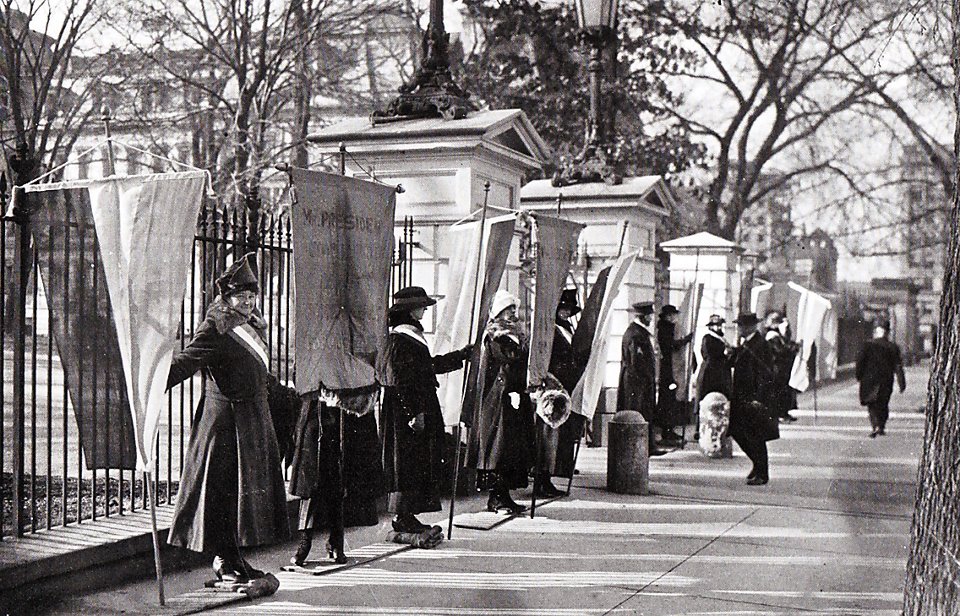
Over the past few weeks, I have had the pleasure and pain of hearing the stories of women whose hearts are broken with a desire to witness quintessential Mormon moments. These women want to witness baby blessings, baptisms, temple sealings, and worthiness interviews. People are telling me their stories when I meet them; people are handing me postcards with detailed memories; and people are sharing their stories on Facebook and Twitter. Women are ready to witness.
Today, I am excited to invite you all to witness something in person: the delivery of our postcards and stories to the Church Administration Building. Come with us on Friday, April 1st as we ask our leaders to accept these stories so that they can read them. Stand with us on April 2nd and 3rd as we hold space outside the Church Administration Building. You can RSVP here to let us know you will be there.
I look forward to standing there demonstrating with my body the sincere prayer of my heart to be counted as a capable witness. It would mean so much more to stand next to many of you who share that prayer.
